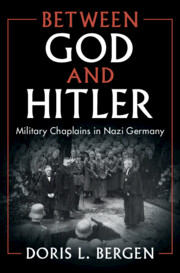Book contents
- Between God and Hitler
- Between God and Hitler
- Copyright page
- Contents
- Figures
- Table
- Preface
- Acknowledgments
- Note on the Text
- Abbreviations
- Introduction
- 1 “We Will Not Let Our Swords Get Rusty”
- 2 “In Times of Peace the Church Arms Herself for War”
- 3 “Gott mit uns”
- 4 Saving Christianity, Killing Jews
- 5 “The Power of Christian Truth and Christian Faith”
- 6 “What Should We Preach Now?”
- 7 From Nazi Past to Christian Future
- Conclusion
- Notes
- Bibliography
- Index
5 - “The Power of Christian Truth and Christian Faith”
Genocidal Culture, 1942–1943
Published online by Cambridge University Press: 14 April 2023
- Between God and Hitler
- Between God and Hitler
- Copyright page
- Contents
- Figures
- Table
- Preface
- Acknowledgments
- Note on the Text
- Abbreviations
- Introduction
- 1 “We Will Not Let Our Swords Get Rusty”
- 2 “In Times of Peace the Church Arms Herself for War”
- 3 “Gott mit uns”
- 4 Saving Christianity, Killing Jews
- 5 “The Power of Christian Truth and Christian Faith”
- 6 “What Should We Preach Now?”
- 7 From Nazi Past to Christian Future
- Conclusion
- Notes
- Bibliography
- Index
Summary
Chapter 5 deals with the years 1942 and 1943, as the Germans reached the peak of their military success and then began to decline. Chaplains were part of the brutal regimes of occupation that characterized Nazi German domination of territories and people. The chapter uses the concept of "genocidal culture" to analyze how Christianity, embodied in the chaplains and symbolized by the cross, helped the Germans construct a story of justification that erased their victims and presented themselves as suffering heroes. Examples from France, Greece, North Africa, and the Soviet Union are presented, and personal accounts from Jewish survivors reverse the gaze, to provide a look at the Germans and their religious practices from outside the group. Amidst the extreme yet everyday brutality of German occupation, the Wehrmacht chaplains turned inward to focus on providing comfort to the men they served and interpreting the war and their role as the ultimate sacrifice. They faced disinterest and at times hostility from soldiers and officers but insisted they were effective “handmaids of the troop leadership.” Chaplains who died or were killed became important figures in a redemptive story of the war.
Keywords
- Type
- Chapter
- Information
- Between God and HitlerMilitary Chaplains in Nazi Germany, pp. 147 - 171Publisher: Cambridge University PressPrint publication year: 2023

